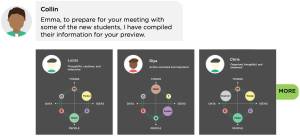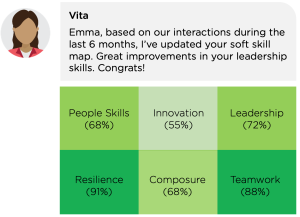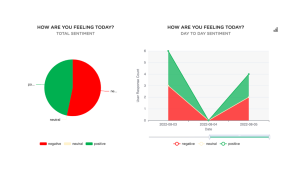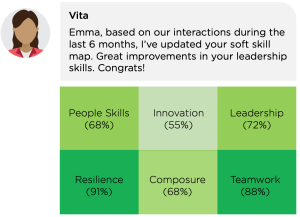
No-Code AI Beings are Shaping the Future of Work
With technological advances, modern organizations face two increasing but related challenges: optimizing business processes through automation and building a competent and resilient workforce that will embrace and advance automation.
On the one hand, organizations wish to adopt advanced technologies, such as Artificial Intelligence (AI), to automate their business processes and make their businesses more efficient and profitable. On the other hand, automation often requires technology expertise (e.g., AI and programming expertise) that organizations may not have or could not afford.
A Workforce Without Limits
The same technological advances also pose challenges for today’s workforce. Employees fear being replaced by machines, especially frontline employees like customer service representatives and manufacturing floor workers, many of whom often work for low wages and feel trapped in their positions. However, technologies can bring better job opportunities, which present employees with career advancement opportunities and social mobility.
The key question is how technology advancements can enable business processes to become more efficient while helping organizations build a competent and resilient workforce.
Since AI is an essential ingredient of technology advancements that enable more efficient processes via automation, the current trend of no-code, reusable AI could fundamentally change the future of work.
With AI and humans working side by side, it leads to a hybrid workforce that unifies human and machine intelligence (AI), where employees are the supervisors and users of AI beings.
Such a hybrid workforce will benefit from human employees’ strengths, such as creativity and analytic skills, while taking full advantage of machine powers to automate repetitive tasks and augment human capabilities.
Employees as Supervisors of AI Beings
Imagine the work life of Emma, a learning coordinator for an edtech company that provides a learning and coaching platform for adults. Every month, Emma onboards a new cohort of thousands of learners/students for different educational programs. These first-time managers look to gain leadership skills, and the first-time coders will participate in a coding bootcamp.
Every month, Emma feels overwhelmed by numerous and often repeated questions from the new students, not to mention that she also needs to check in on the new cohort periodically, keeping them engaged and advising them on their learning journey.
Now imagine an expanded team, Emma and her AI assistant, Collin.
Not only can Emma configure Collin (with no code!) to answer frequently-asked learner questions, but she can also task Collin to check in on the new students periodically and gather their thoughts and feelings.
During these interactions, Collin can also automatically infer students’ preferred learning styles and potential learning challenges, which enables Emma and her human colleagues to tailor their advice to each student.
In this scenario, Emma is the supervisor of Collin and is teaching him (it) new knowledge and improving his (its) ability to interact with students.
On the other hand, Collin augments Emma’s time and knowledge of each student, enabling her to do her job more efficiently and effectively.
 |
| Three example student profiles inferred by Collin through its interactions with the students. Such info will help Emma better interact and help the new students. |
Can Emma Benefit From an AI Assistant Like Colin?
It is not hard to imagine that many employees like Emma could benefit from having an AI assistant like Colin. They can assist employees in multiple industries, including education, healthcare, financial services, and talent management.
With no-code, reusable AI tools, employees can configure and supervise their own AI assistants as easily as they use office tools like Powerpoint to prepare presentations and Word to create documents.
Similar to listing Powerpoint and Word as skills in their resume, employees who can manage AI assistants can also list “AI supervision” as a skill, improving their capabilities of working in a hybrid workforce and expanding their career possibilities.
In other words, not only will such employees not be replaced by machines, but they will also improve their career opportunities and social mobility.
Employees as Users of AI Beings
Let’s continue using Emma as an example. Emma does not want to be a learning coordinator for the rest of her career. She wants to get promoted and manage a team or even become a certified leadership coach.
To help employees like Emma develop their careers, organizations have also started utilizing AI to serve as an employee’s workplace companion or buddy.
A Happier and More Productive Workforce
One of the sweet spot practices for creating a happier and more productive workforce is to engage with employees in two-way conversations, answering their questions and listening to their needs and wants whenever they want.
While few organizations can afford to perform such a practice, an AI workplace buddy can certainly help. By submitting her job application, Emma is paired with an AI workplace buddy, Vita.
To help Emma find the role that suits her the best, Vita interviews Emma and infers her strengths and weaknesses from the interview. Based on Emma’s strengths and weaknesses, Vita could match Emma with suitable roles.
Furthermore, Vita always keeps in touch with Emma, answering her questions regarding career development or employee benefits, asking about her thoughts and feelings, assessing her skills, and using this information to notify Emma about new career opportunities or find mentors who may be a good match.
 |
| Through its interactions with Emma, Vita infers Emma’s soft skill map. |
In addition to serving as Emma’s workplace buddy and aiding her in career development — AI assistants like Vita also greatly aid organizations in identifying and retaining talent.
As this New York Times article mentions, existing recruitment tests hardly elicit authentic results due to subjective, self-rated responses. Yet, an AI assistant like Vita can objectively infer unique characteristics from a conversation, eliminating potential faking and subjective scales.
Continuous Employee Engagement
Continuous employee engagement and proactive, personalized career guidance that an AI workplace buddy like Vita can deliver at scale and will also help organizations retain talent.
As Erica Keswin mentions in her recent book “Rituals Roadmap,” replacing an employee typically costs 50% to 200% of the employee’s salary while making professional development personal helps retain talent.
With many employees now working remotely, AI workplace buddies can also help organizations gain better insights into their workforce. An employer can gain a better understanding of their employees’ thoughts and feelings in a timely manner. The employee’s needs can be addressed, and course corrections made much more promptly.
In short, through these two-way conversations between employees and their AI workplace buddies, not only can an organization obtain continuous workforce insights, but they can also use the insights to plan the next best actions, such as talent retention and helpful career development.
 |
| AI workplace buddies like Vita are able to produce continuous, real-time workforce insights based on their interactions with employees. |
Thanks to the availability of no-code, reusable AI, human resources professionals are empowered to configure and supervise AI workplace buddies on their own. Human resources can easily teach these AI beings domain knowledge without requiring the help of IT professionals — saving much-needed time and energy — and money that any other system will cost.
Responsibilities of Organizations for Reskilling and Upskilling
Investing in company talent benefits both employees and organizations in the long run. As the world continues to become increasingly powered by advanced technologies, it is every organization’s responsibility to help improve the skills of its workforce.
In particular, organizations should improve the skills of their workforce in two areas: AI literacy and Analyst skills.
AI literacy as a skill
AI literacy is the basic understanding of AI principles, including its benefits and limitations, and how to use no-code AI tools. It enables employees to supervise AI beings as well as leverage AI to benefit themselves, including career development and mental wellness.
Analyst skills
The future of work relies on making decisions based on data. Enabling employees to have an analyst’s mind and make data-driven decisions is especially important as AI democratizes data analytics processes.
For example, human resource professionals should be able to take advantage of the insights inferred by AI workplace buddies like Vita to make decisions around matching an employee with a job role or mentor.
Facing the “great resignation”
Facing the “great resignation” and economic downturn, organizations now must handle a greater number of challenges. No matter what challenges there are, people are still the core of any organization.
With advances in AI and its democratization through no-code, reusable AI tools, organizations, including non-IT teams, can now take full advantage of AI to build a hybrid workforce.
A hybrid workforce can leverage machine intelligence and human talents who are the best fit for the organization, skill-wise and culturally – truly creating a workforce without limits.
Featured Image Credits: Photo by Pavel Danilyuk; Photo by Pavel Danilyuk; Pexels; Thank you!





